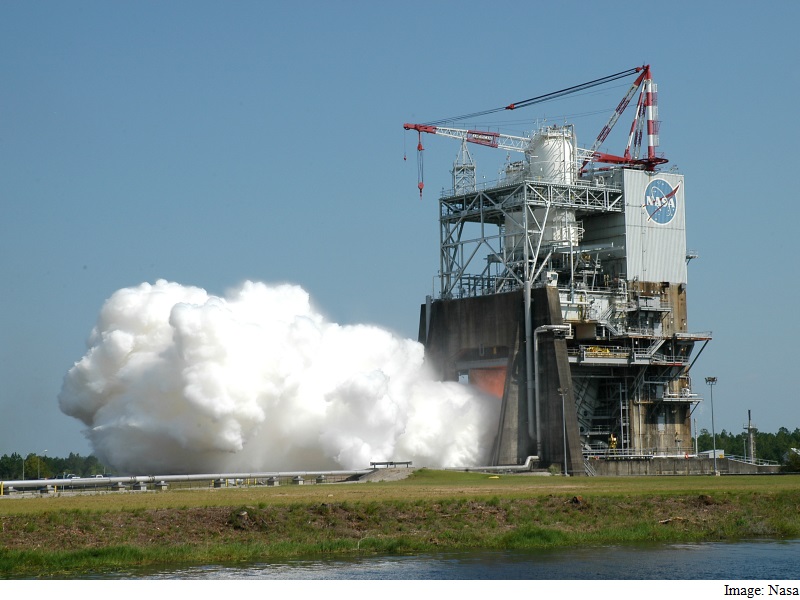- Home
- Science
- Science News
- Nasa Successfully Tests SLS Space Launch System's RS 25 Rocket Engine
Nasa Successfully Tests SLS Space Launch System's RS-25 Rocket Engine

The 535-second test of RS-25 rocket engine at Nasa's Stennis Space Center near Bay St. Louis, Mississippi, was aimed to collect engine performance data, the US space agency said in a statement.
An initial 77-tonne SLS configuration will use four RS-25 engines for the core stage, along with two five-segment solid rocket boosters, providing more lift to orbit than any current launch vehicle.
One final test of this RS-25 developmental engine is left and testing of flight engines will begin later this fall.
The core stage for the first SLS and Orion integrated flight will also be tested at Stennis.
That test will involve simultaneous firing of the four RS-25 engines just as during an actual launch.
Powered by four RS-25 engines, the SLS will send the Orion spacecraft into deep space missions.
"The RS-25 engine gives SLS a proven, high performance, affordable main propulsion system for deep space exploration," Nasa said.
It is one of the most experienced large rocket engines in the world, with more than a million seconds of ground test and flight operations time.
When completed, SLS will enable astronauts to begin their journey to explore destinations far into the solar system.
During the joint Senate-Nasa presentation in September 2011, it was stated that the SLS programme has a projected development cost of $18 billion (roughly Rs. 1,16,973 crores) through 2017.
It will be divided into $10 billion (roughly Rs. 64,994 crores) for the SLS rocket, $6 billion (roughly Rs. 38,997 crores) for the Orion Multi-Purpose Crew Vehicle and $2 billion (roughly Rs. 12,997 crores) for upgrades to the launch pad and other facilities at the Kennedy Space Center.
Get your daily dose of tech news, reviews, and insights, in under 80 characters on Gadgets 360 Turbo. Connect with fellow tech lovers on our Forum. Follow us on X, Facebook, WhatsApp, Threads and Google News for instant updates. Catch all the action on our YouTube channel.
Related Stories
- Samsung Galaxy Unpacked 2025
- ChatGPT
- Redmi Note 14 Pro+
- iPhone 16
- Apple Vision Pro
- Oneplus 12
- OnePlus Nord CE 3 Lite 5G
- iPhone 13
- Xiaomi 14 Pro
- Oppo Find N3
- Tecno Spark Go (2023)
- Realme V30
- Best Phones Under 25000
- Samsung Galaxy S24 Series
- Cryptocurrency
- iQoo 12
- Samsung Galaxy S24 Ultra
- Giottus
- Samsung Galaxy Z Flip 5
- Apple 'Scary Fast'
- Housefull 5
- GoPro Hero 12 Black Review
- Invincible Season 2
- JioGlass
- HD Ready TV
- Laptop Under 50000
- Smartwatch Under 10000
- Latest Mobile Phones
- Compare Phones
- Realme P4x 5G
- OnePlus Ace 6T
- OPPO A6x 5G
- Samsung Galaxy Z TriFold
- Poco F8 Ultra
- Poco F8 Pro
- Huawei Mate 80 RS Master Edition
- Huawei Mate 80 Pro Max
- Asus ProArt P16
- MacBook Pro 14-inch (M5, 2025)
- Poco Pad M1
- Poco Pad X1
- Just Corseca Skywatch Pro
- Honor Watch X5
- Acerpure Nitro Z Series 100-inch QLED TV
- Samsung 43 Inch LED Ultra HD (4K) Smart TV (UA43UE81AFULXL)
- Asus ROG Ally
- Nintendo Switch Lite
- Haier 1.6 Ton 5 Star Inverter Split AC (HSU19G-MZAID5BN-INV)
- Haier 1.6 Ton 5 Star Inverter Split AC (HSU19G-MZAIM5BN-INV)

















